

In the past, the works of art masters had to go through a long and arduous process of imitation and copying before they could be retained or sold to unsuspecting buyers. Now with the help of AIGC technology, users can create works by selecting a specific genre, as if they can imitate the master's work in an instant.
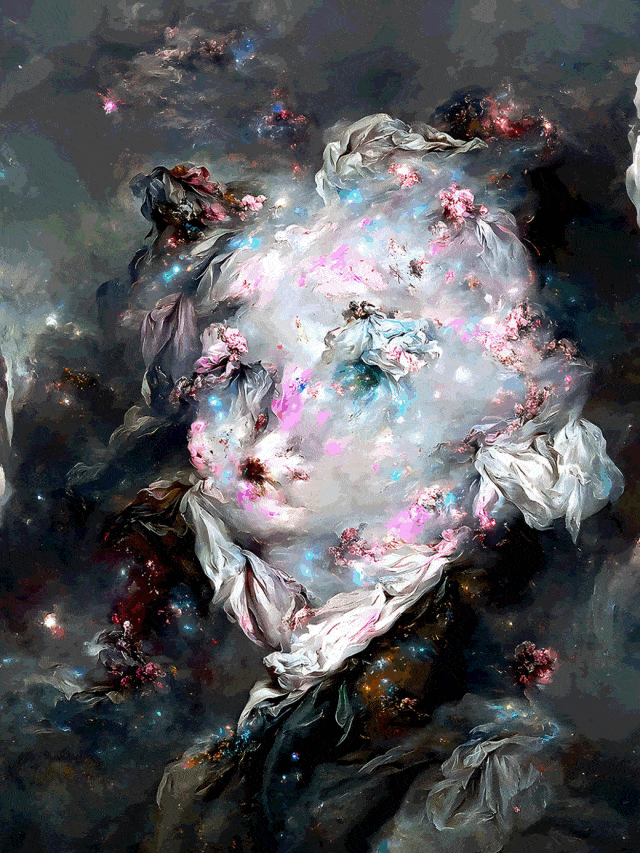 Yuan Vision Digital Collection "AI Stan" Series
Yuan Vision Digital Collection "AI Stan" Series
The existing art image database becomes a data training source for AI, enabling it to learn and understand the characteristics, style and content of artistic creation. After data training, the AI model is built. These models, often based on deep learning techniques, are able to analyze incoming data and generate new works of art. When creating art, users need to input or adjust parameters to control the results of creation. After the AI model generates works of art, users can provide feedback and evaluations, which will be used to further improve and optimize the AI model and enhance the quality and diversity of its artistic creations.
Part 01
Industry Exploration:
The waves caused by AIGC in the art industry
Recently, AI generation platforms such as Midjourney and Stable Diffusion are receiving great attention from society. Images, etc. are being generated conveniently and effectively through AI. They all fall under the category of AIGC (Artificial Intelligence Generated Content), by extracting and understanding intent information from instructions provided by humans, and generating content based on their knowledge and intent information.
It is obvious that AIGC is having a profound impact on the development of the art industry. Let’s look back through the stages to trace several important interactions and landmark achievements between AIGC and the art industry.
From the early 2000s to the early 2010s, researchers and artists began to explore the application of artificial intelligence technology to artistic creation. Although the technology is not yet mature enough, some projects are starting to get involved in this field, such as art generation algorithms and computer-based art experiments.
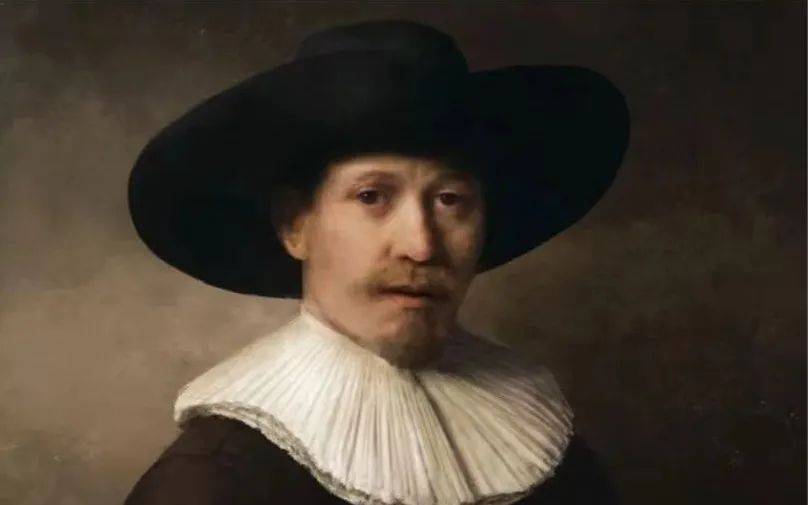 AI-generated “Rembrandt-style” portrait
AI-generated “Rembrandt-style” portrait
In the early 2010s, with the rapid development of deep learning technology, AIGC made major breakthroughs in the art field. Deep learning models such as convolutional neural networks (CNN) and generative adversarial networks (GAN) are beginning to be applied to tasks such as image generation and style transfer. These technologies enable computers to imitate an artist's style and generate artistic images and compositions. For example, the DeepDream project released by Google in July 2015 uses convolutional neural networks to find and enhance patterns in images to generate hallucinatory images through the algorithm Pareidolia [1].
In the mid-2010s, AIGC achieved breakthroughs in machine creation. Machine learning models can generate independent works of art, music and literature. In 2018, "Portrait of Edmond de Belamy, 2018", the first artwork created through artificial intelligence in history, was sold at a Christie's auction in New York for US$432,500[2] , marking the first commercial success of machine creation. The work, created by an artificial intelligence algorithm developed by Paris-based art collective Obvious, depicts a portrait of a fictional member of the Bellamy family.
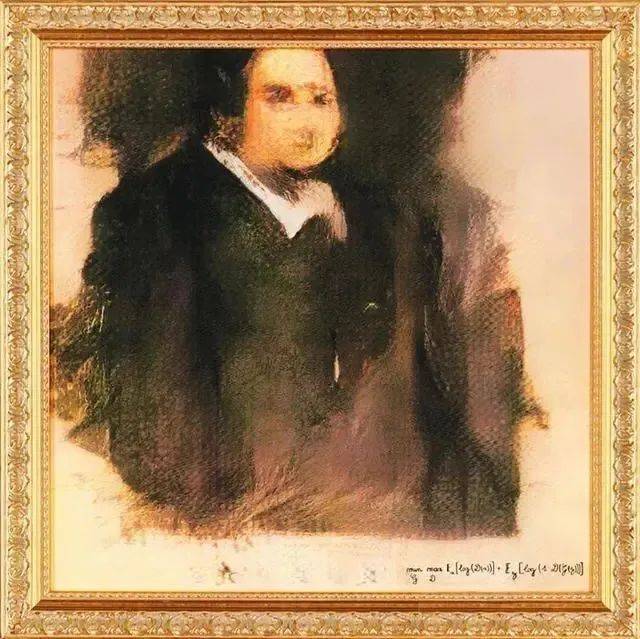 "Portrait of Edmond de Bellamy" created by AI
"Portrait of Edmond de Bellamy" created by AI
In early 2021, text-to-image algorithms began to emerge, starting with the release of DALL-E, followed by open source algorithms such as VQGAN. CLIP released by OpenAI has become an important node for cross-modal text and text. As a classic cross-modal retrieval model for text and text, CLIP has been pre-trained for comparative learning on a large-scale picture and text data set, and has strong cross-modal text and picture capabilities. State representation learning ability [3].
In 2022, the Diffusion Model will become the core method in the field of text generation images. Currently the most well-known and popular text generation image models, Stable Diffusion, Disco-Diffusion, Mid-Journey, DALL-E2, etc. are all based on the diffusion model. DALL.E2 was launched by OpenAI company, and its biggest feature is its amazing understanding and creativity[4]. Due to its simple interaction and fast generation speed, Stable Diffusion set off an AI creation boom as soon as it was opened in August 2022 [5]. Midjourney, which has become a phenomenal application today, entered public beta as early as July 12, 2022. Thanks to its advantages such as being able to intelligently assist users in drawing, it achieved revenue of US$100 million in less than a year. .
2023 can be called the "first year of AIGC". AIGC has gained widespread public attention as a social topic. A landmark event in the art field is Adobe's integration into AI creation. The first-generation Adobe Firefly model focuses on the creation of image and text effects. It is trained on hundreds of millions of professional-grade licensed images in Adobe Stock, as well as publicly licensed content and expired public domain content, and adopts a powerful style. The engine is enhanced to create photo, artistic, graphic and text effects with impressive control of style, color, tone, lighting and composition.
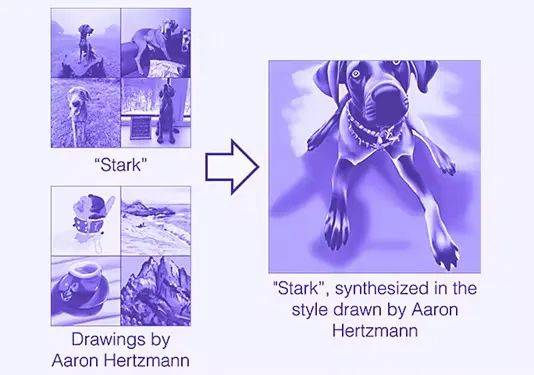 Creators can take advantage of Adobe Firefly’s “customizable diffusion” feature to select images that inform the AI
Creators can take advantage of Adobe Firefly’s “customizable diffusion” feature to select images that inform the AI
These key events indicate that AIGC is making breakthroughs in the art industry and bringing new opportunities and challenges to artists, audiences and the market. As technology continues to advance, AIGC will continue to play an important role in the art field and promote innovation and exploration in artistic creation.
Part 02
Voice of the Arts: Tools, Plagiarism? Or a source of inspiration?
See how artists respond to AIGC
In August 2022, "Space Opera" produced by Jason Allen, as the first artwork created by AI, won the grand prize in the Emerging Digital Artist Competition held in Colorado, USA. The artist first draws a rough draft through Midjourney, and then uses computer software to make some refinements [6]. The results of this competition also triggered a heated discussion on "AIGC's artistic creation". If a work drawn with the help of tools comes out on top, is this considered art? Will it have an impact on artists’ creations?
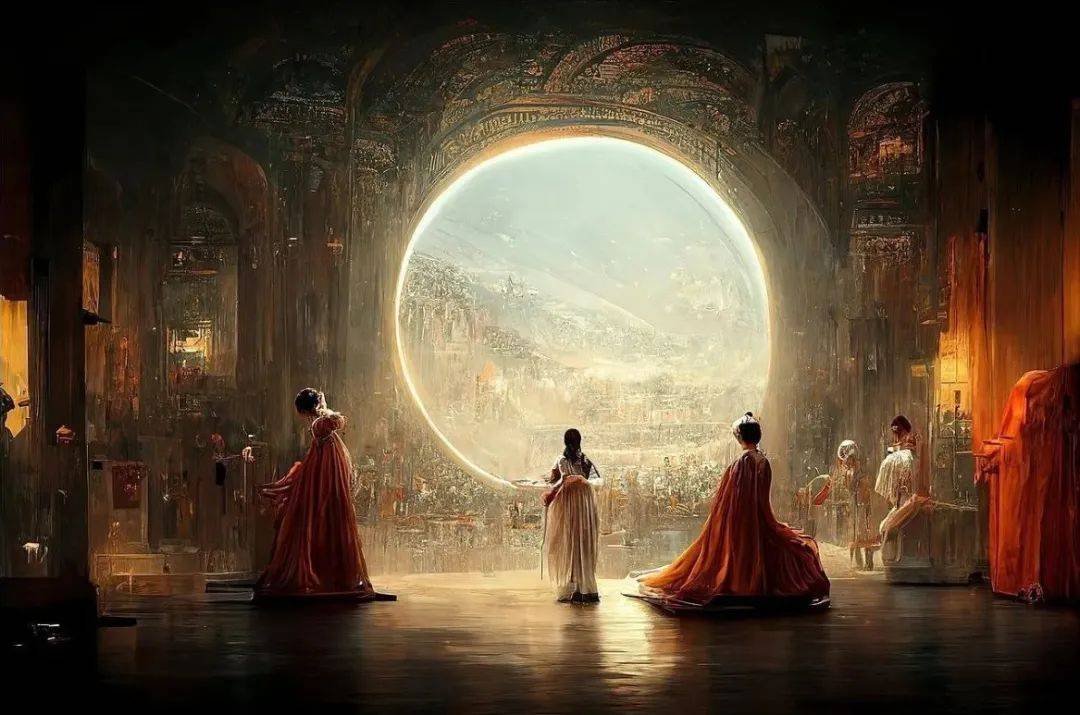 Jason Allen's "Space Opera" produced by Midjourney
Jason Allen's "Space Opera" produced by Midjourney
Although the main players of AIGC have mainly entered the game in the past two years, in some fields, such as conceptual art and digital illustration, a large number of artists have begun to find inspiration through AIGC and integrate the generated results into their artistic works. in [7].
According to Brennan Buck, a practicing architect at the Yale School of Architecture, the role of artificial intelligence here is more similar to a tool that mainly plays a role in the conceptual stage of the project. Artificial intelligence can help artists color or scale images, but these small contributions do not have a critical impact on the overall creativity [8].
It is undeniable that AIGC technology is democratizing image generation under the wave of the creator economy era. Some people believe that although there may be conceptual conflicts between AI art creators and traditional artist groups in the short term, in the long run, the two will remain distinct [9]. The reason is that the current AI art produced is more like a fast-moving consumer goods and faces a different market than traditional art.
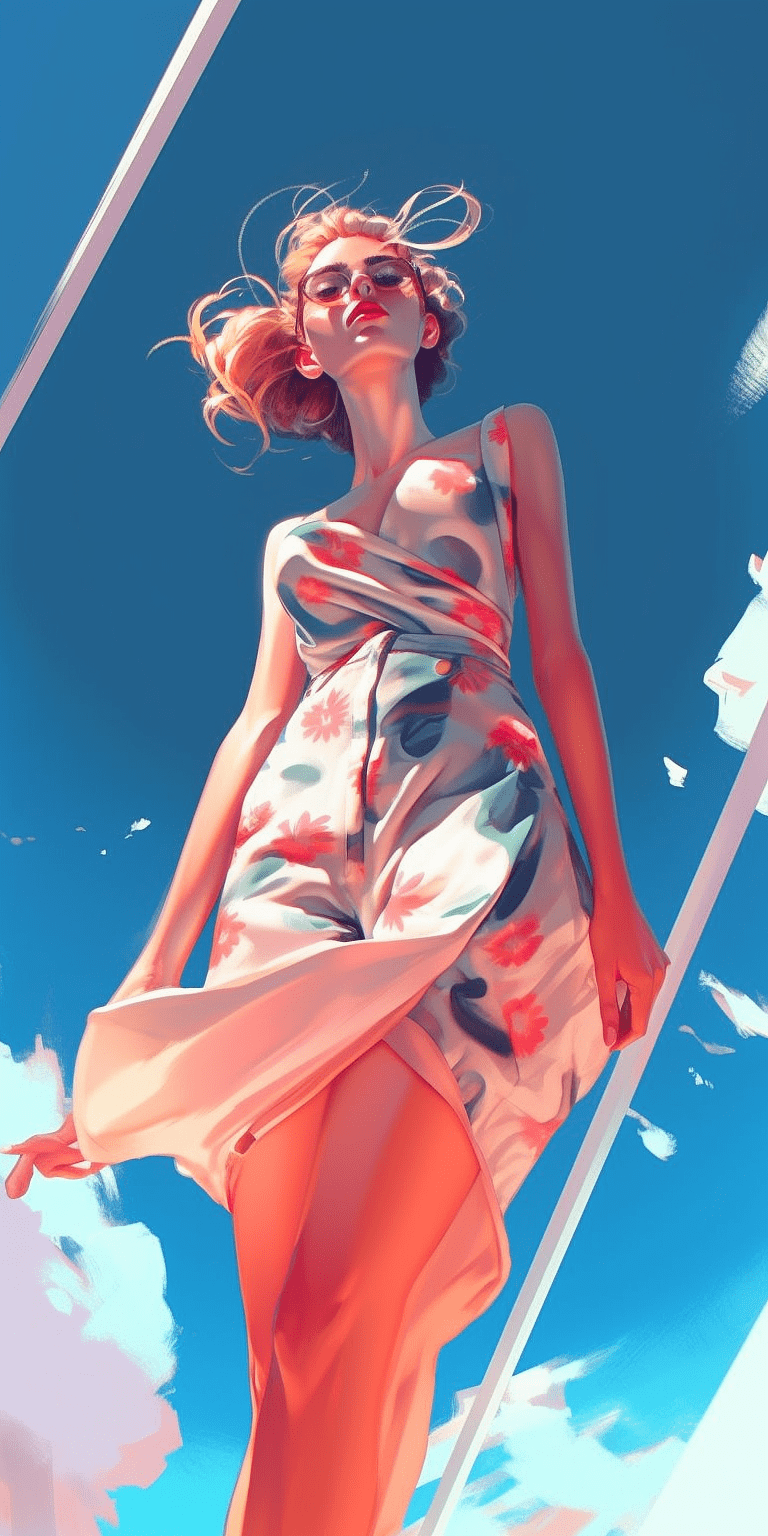 AI Painting
AI Painting
On the other hand, plagiarism has become an important reason why AIGC has been criticized. Art works published on online platforms have become resources that the AIGC platform can capture and copy. NightCafe Studio founder Angus Russell said that in early April 2023, three artists filed a class action lawsuit against top artificial intelligence art generators, including Stability AI, Midjourney and DeviantArt, because these artificial intelligence companies did not obtain consent or Provide compensation for using copyrighted images to train their algorithms [4].
The above situation is not an isolated case. Possible infringement is becoming a major problem for any well-known artist and illustrator today. In March 2023, during a keynote speech on art and artificial intelligence in Chicago, University of Chicago computer science professor Ben Zhao pointed out that artists may not only face a loss of income, but may also find their artistic identity diluted. "Artificial intelligence art models cannot yet replace human artists through 'training', but artificial intelligence is already subverting the art industry." Ben Zhao added that some artists may stop displaying their art on personal websites to prevent their works from being published in the future. Crawled with permission[10].
 Yuan Vision Digital Collection "Illusion in the Wall·Fantastic Animals"
Yuan Vision Digital Collection "Illusion in the Wall·Fantastic Animals"
Accordingly, Ben Zhao collaborated with his colleague Heather Zhen to develop a program called GLAZE, which can be applied to platforms such as Stable Diffusion, Midjourney and DALL-E to protect artists' works from unauthorized theft. . The principle is that GLAZE interprets the works published by artists online, producing changes in style to interfere with the AI's copying process.
Even so, copying has long existed in the art world, often in an evaluation context that is not pejorative. In the past, artists would copy the works of masters as an important part of their learning process, in order to hone their skills and develop their own aesthetic. In the last century, artists like Andy Warhol worked with existing images to achieve critical ends. On this basis, Damon Willick, professor of art history at LMU, pointed out that artificial intelligence has not achieved these two purposes-it has neither enhanced the images it copied nor achieved criticism, but has only carried out a kind of pure plagiarism[10] .
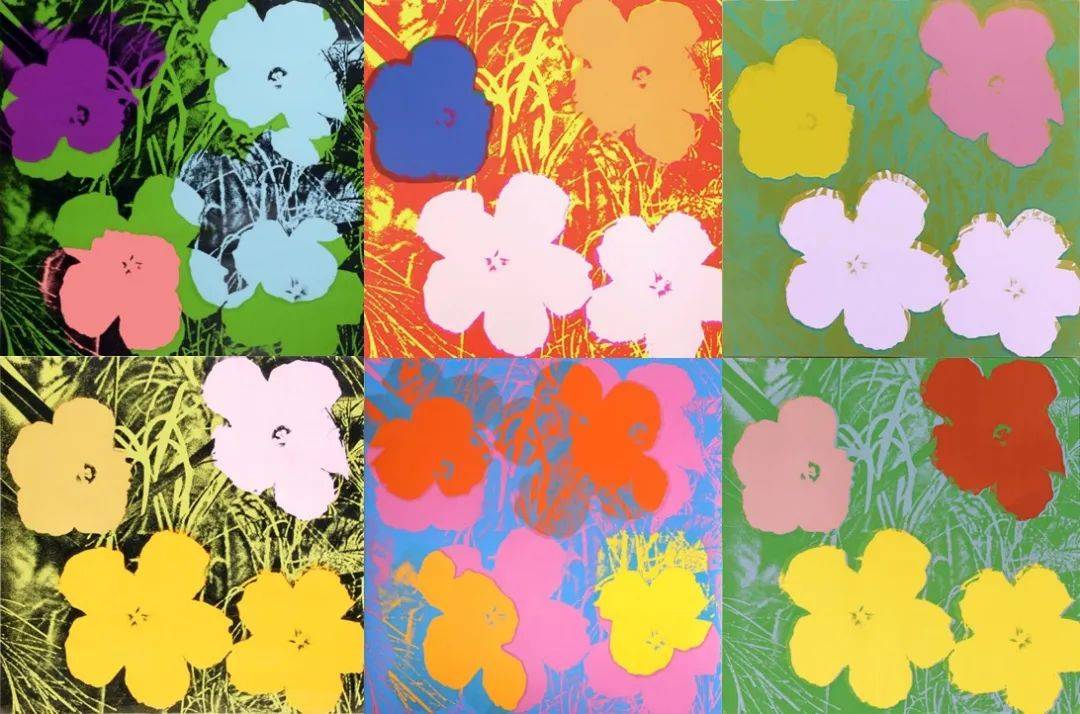 Andy Warhol's screen printing work "Flowers" series (part) created in 1970
Andy Warhol's screen printing work "Flowers" series (part) created in 1970
In addition to being used as a creative tool, art lovers who use AIGC to create purely out of interest or self-healing will still exist. AI art triggers a hit of dopamine and a sense of pride and accomplishment that people simply couldn’t get before. Many people like to use AI to create art. NightCafe Studio, for example, says it often receives feedback that AI art has picked up a "creative itch" that people didn't expect, or that people just use it religiously as a way to relax and de-stress. [4].
Part 03
The beauty of numbers:
Digital art and digital migration under the influence of AIGC
From the perspective of media form, digital art is one of the art forms most closely related to AIGC. Abandoning metaphors for traditional media materials, digital art can be purely computer-generated, or it can be obtained from other sources such as scanned photographs or drawings using graphics software or a graphics tablet. Nowadays, with the support of AR, VR, NFT and other technologies, the creation and circulation of digital works have gained new empowerment, and AI technology provides increasingly intelligent underlying logic for the generation of digital works.
With the maturity of technologies such as GAN, new forms of digital art creation and presentation have begun to attract the attention of artists. Generative adversarial networks (GANs) are a method of unsupervised learning that learns by playing two neural networks against each other. More famous creators include visual artist Helena Sarin, whose works bear the characteristics of German Expressionism, using limited colors and flat graphics to construct a collage-like infinite world.
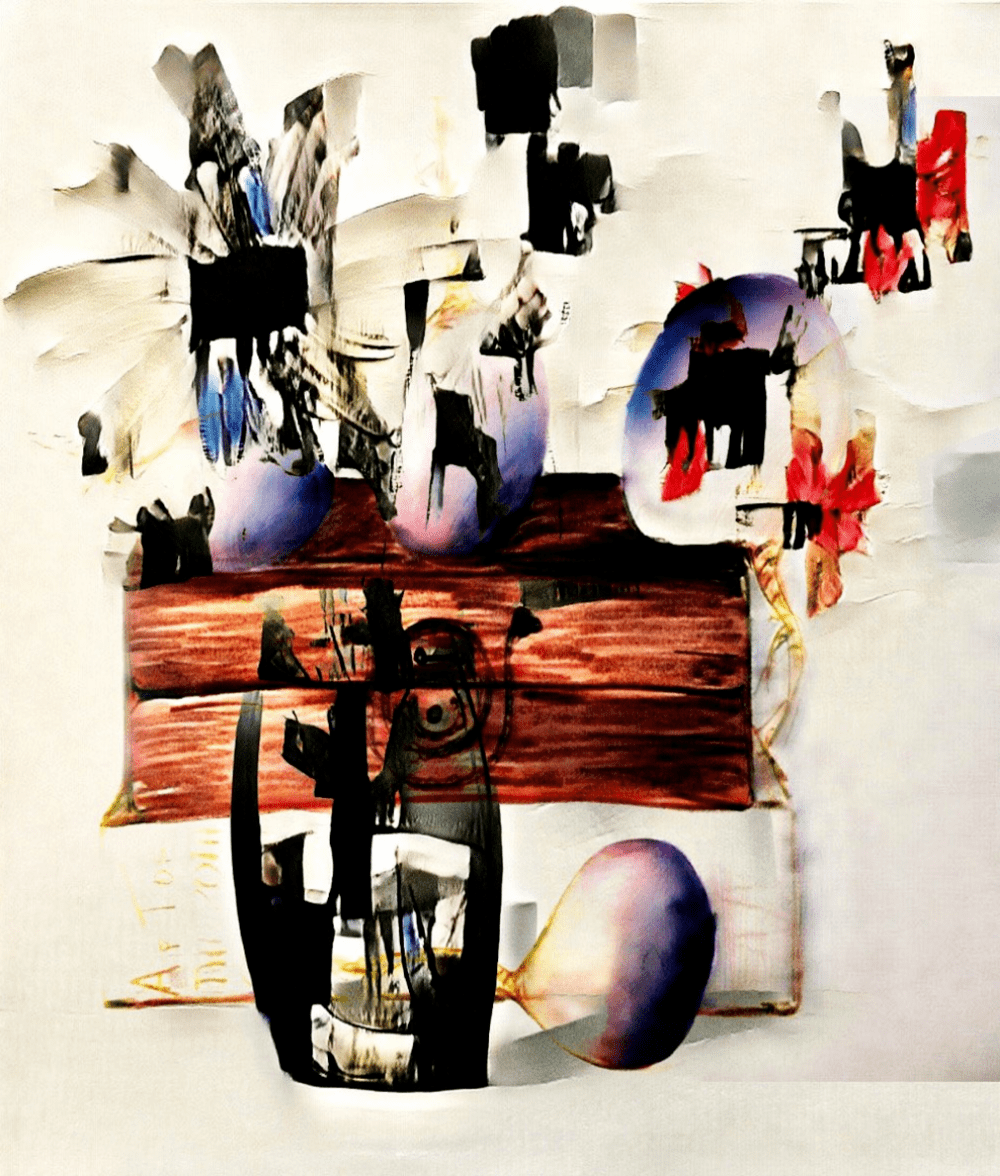 "Am I Dali", Helena Salin 2018 (Jeremy Howard Collection)
"Am I Dali", Helena Salin 2018 (Jeremy Howard Collection)
Humans and machines collaborate to create art, which has become another form of digital interpretation. Sougwen Chung, a pioneer in the field of human-machine collaboration and a former researcher at the MIT Media Lab, is a Chinese-American interdisciplinary artist. She is committed to exploring mark-making collaboratively created by humans and machines, aiming to gain a deeper understanding of the interaction between humans and computers. In the art project "Drawing Operations Unit", Zhong Sujun adopted Google's TensorFlow framework, transferred his own drawing style and methods to the robotic arm, and collaborated with it to create. She also applied a series of technical means to expand the concept of human-machine collaboration. These trained neural networks can generate changes in images and sketch based on human drawings [11].
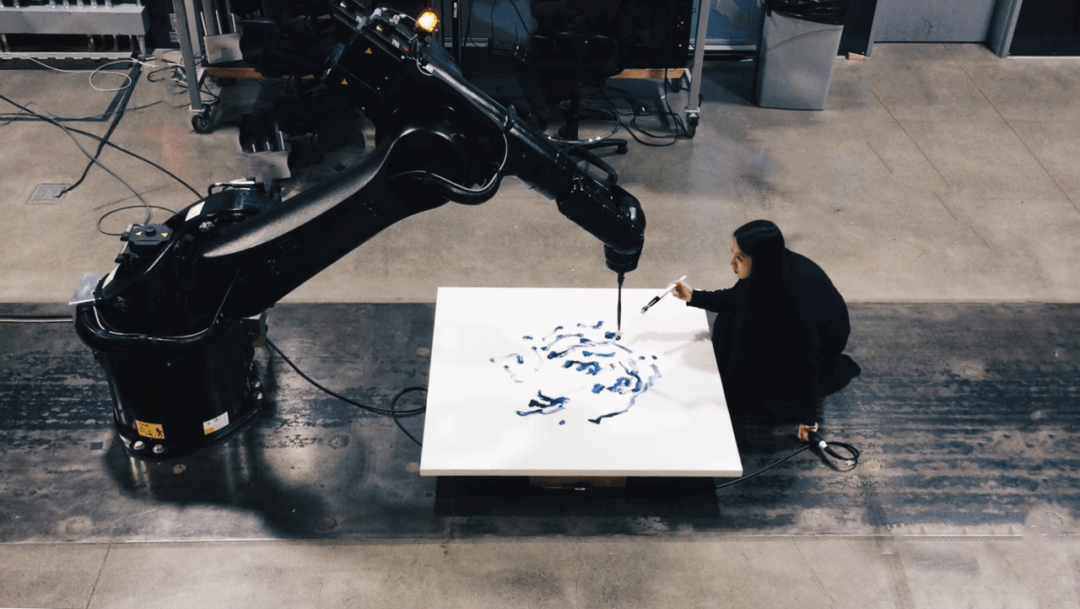 Zhong Sujun and "Drawing Operations Unit"
Zhong Sujun and "Drawing Operations Unit"
In the book "Metaverse, the Road to Infinite Games" written by Babbitt founder Chang Chai and Bytom chief researcher Liu Qiushan, it is mentioned that there are "three stages" in the development of the Metaverse - digital twin, digital native and digital immortality—this is also the process of human digital migration [12]. "Digital twin" refers to mapping the basic materials, assets and cultural symbols of the real world onto the blockchain; "digital native" means creating new knowledge that transcends reality and human cognition; "digital immortality" refers to the real world and the digital world will jointly constitute human life space, and the two are inseparable.
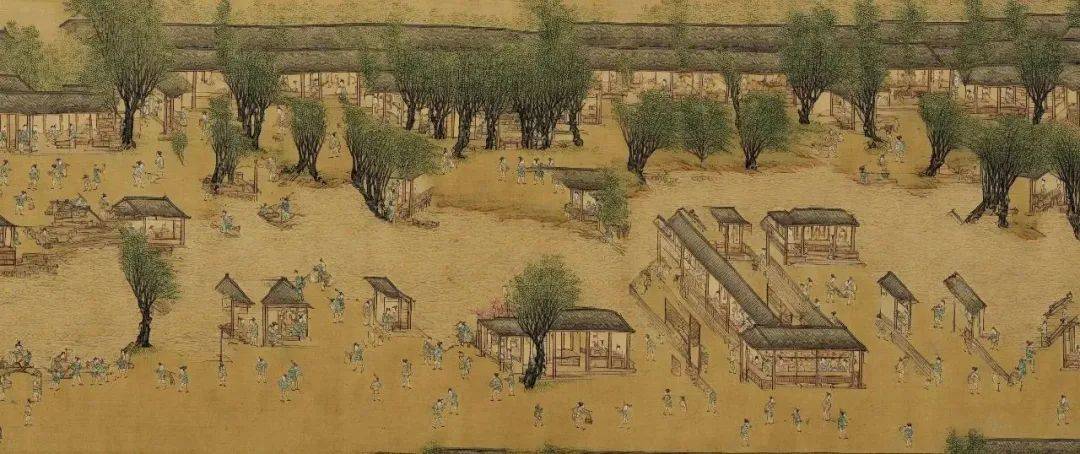 NUWA-Infinity re-created a part of the painting based on the study of "Along the River During the Qingming Festival"
NUWA-Infinity re-created a part of the painting based on the study of "Along the River During the Qingming Festival"
If AIGC art is mapped to digital migration, the current focus is mainly on the first two stages. "Digital twin" is similar to the digitization of traditional works of art; "digital native" is more importantly about changes in the media environment and the emergence of new methods of production, communication and transaction of artistic creation. For example, the New Era Riverside Scene during the Qingming Festival performed by Microsoft's AI art tool Nuwa after extensive learning is a work in the digital twin stage. The Miss Journey portrait was created "out of thin air" by the AI algorithm under the joint imagination of millions of people in the Midjourney community. It has created such a "new human being" and thus belongs to digital native art.
 Portrait of Miss Journey
Portrait of Miss Journey
Part 04
Empowering the future:
The combined force signal released by AIGC
What other opportunities and development trends may AIGC bring? Which fields can it be intertwined with to create a stronger synergy?
Judging from the field of occurrence of AIGC art, it mainly occurs in the mainstream Internet world at this stage, but it is impossible to deny that, for example, Stable Diffusion embodies CC0 (Creative Commons Zero License) and other signs of decentralization spirit, web3 Perhaps it will become the next vast fertile ground for AI art. At the same time, it can also be observed that NFT is providing more potential community power and productivity for the development of AI art. Furthermore, since verifiable authenticity is an extremely important dimension of value judgment in the art world, the decentralized and secure nature of blockchain makes it a natural choice for managing artwork ownership and transactions [13].
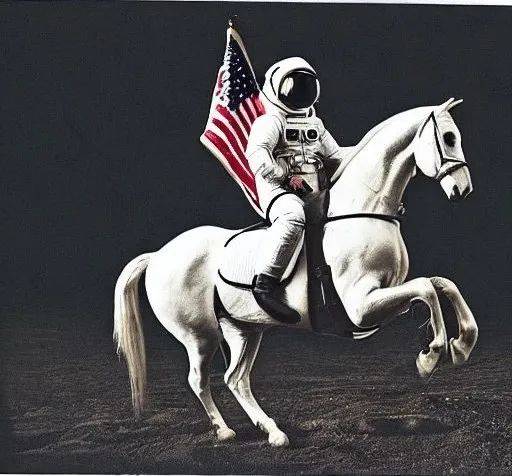 Image generated by user using Stable Diffusion
Image generated by user using Stable Diffusion
Botto is a generative AI art project managed by DAO, which defines its artistic style as "dynamic", a style that constantly evolves by frequently breaking recognizable compositional rules. to create images with strong visual impact. Boto is pushing the boundaries of community-driven creativity at the intersection of AI, DAO, and DeFi. Since October 2021, Botto's art engine has produced 350 drafts, also known as "shards," per week. Through voting by the DAO community, they select the most popular "shards" each week and mint and sell them on SuperRare. The voting data is then fed back to the AI, which learns to generate artwork more in line with the community’s tastes. Botto generates revenue through weekly art sales, royalties, and project collectible sales, with proceeds distributed within the community to reward community participation in the growth and development of the project. Overall, Boto explores the value and significance of public creations, practices the practice of DAO organizations, and builds a creative economic network for crypto artists.
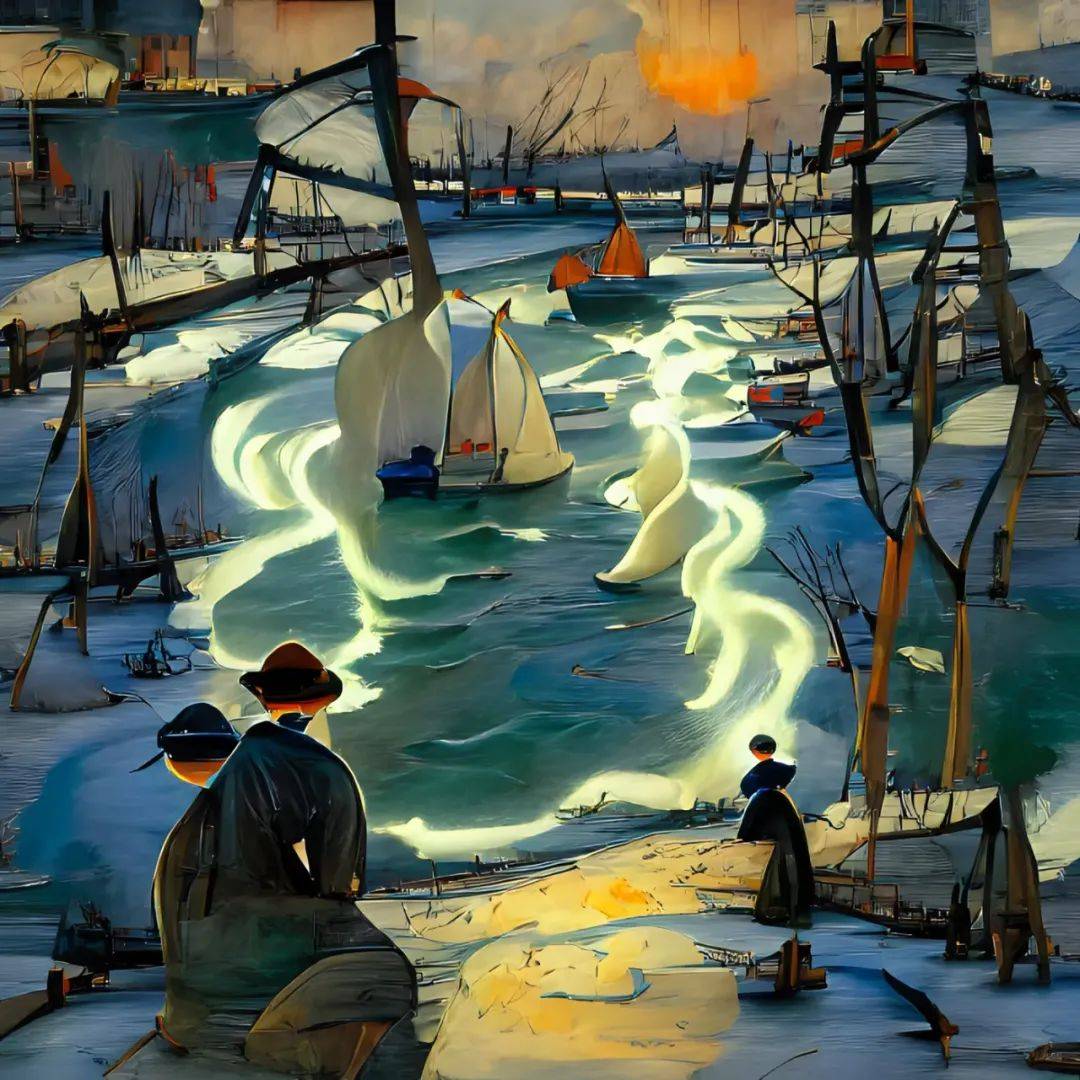 "Seaport Subject" is one of the fragments chosen by the community as the first edition of Boto's work
"Seaport Subject" is one of the fragments chosen by the community as the first edition of Boto's work
Secondly, AIGC has great potential in cross-media and cross-field innovation. Images generated through algorithms can be combined with music, sound effects and dynamic images to break the boundaries between traditional media and create rich and diverse cross-media Art work.
Refik Anadol is a cross-media artist who frequently uses big data collections and machine learning algorithms in his artistic practice to create stunning digital artworks. By feeding data into an AI system, Anadol is able to interpret and present information in an unprecedented way [14]. His "Machine Hallucinations" series includes NATURE DREAMS, WINDS OF BERLIN and ST. AGNES. By feeding approximately 100 years of New York City's history of image data into an AI system, a dazzling visual experience was created. These works process large amounts of image data through deep learning to generate abstract images and visual illusions, presenting an interactive picture of machine and human perception.
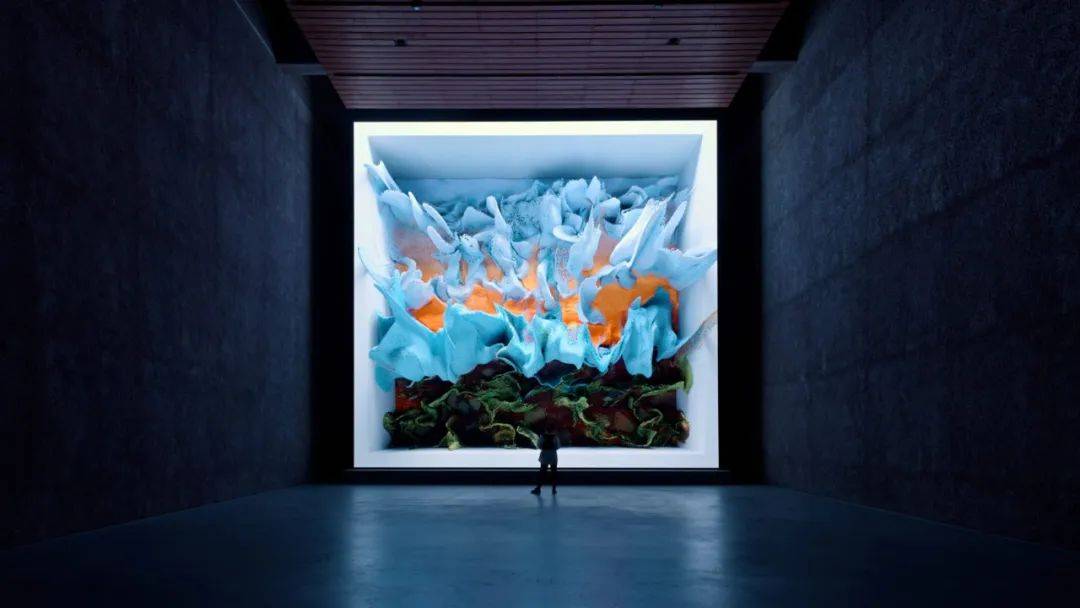 "Dream of the Machine" created by Refik Anadol
"Dream of the Machine" created by Refik Anadol
Such cross-media and cross-field discussions focus on the challenges and possibilities brought by computing to human society, leading the thinking to refocus on human beings themselves, and contain profound synchronic enlightenment significance. As Anadol believes, machines dominate our daily lives today, and he is obsessed with exploring how the perception and experience of time and space have fundamentally changed.
By introducing a new aesthetic technology to create a diverse immersive environment, providing dynamic spatial perception also contributes to the effective realization of embodiment. For example, Anadol integrates cross-media and architectural forms and translates the logic of new media technology from an artistic perspective, thereby inviting the audience to redefine the functions of internal and external architectural elements and realize thinking about the diversity of reality.
Finally, AIGC Art provides audiences with a more interactive and participatory experience. By using innovative tools such as interactive technology and virtual reality, audiences can interact with artworks in real time and participate in the creation and evolution of the works, thereby generating Personalized art experience.
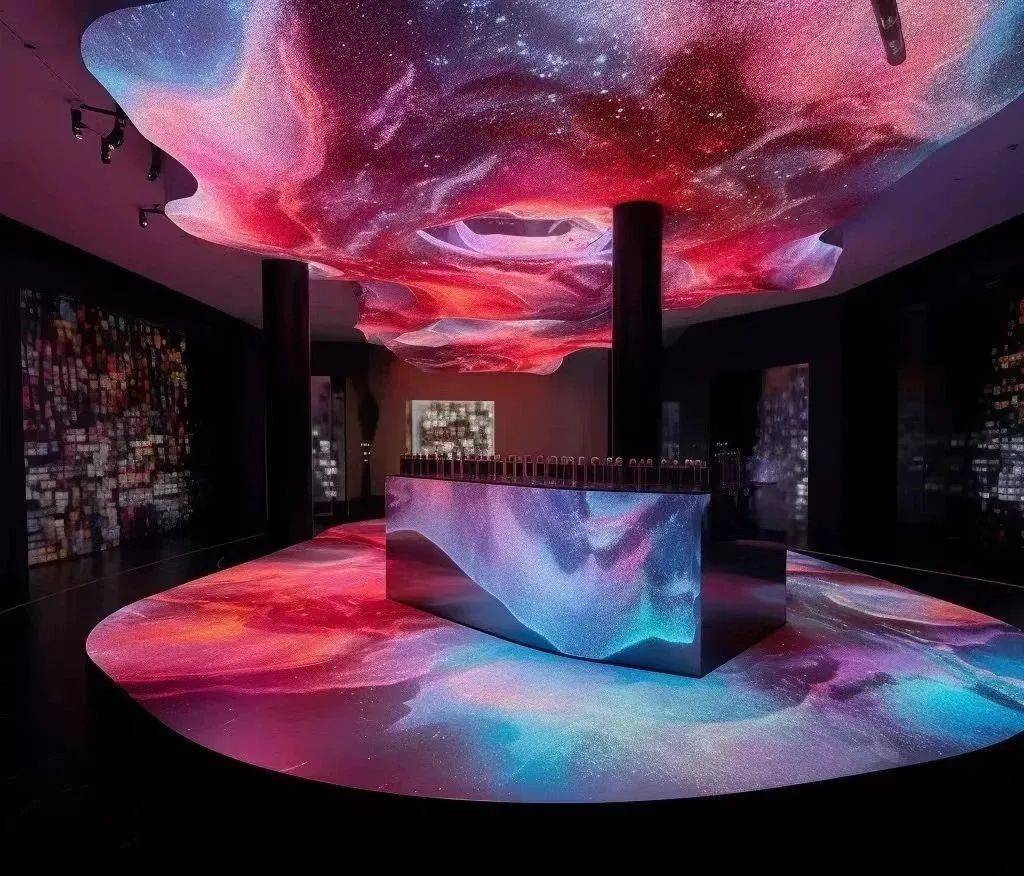 Midjourney Exhibition Hall Design
Midjourney Exhibition Hall Design
Es Devlin is a stage designer and artist who explores the intersection between stagecraft, architecture and digital technologies. She uses content generated by AIGC to create art installations and stage backdrops that interact with the performance through projections and interactive elements [15]. When the audience looks towards the stage, Es Devlin creates a collective AI-Assisted poetry experiment by observing the audience. In 2017, her collective choral installation "THE SINGING TREE" (THE SINGING TREE), co-created with London's V&A, integrated machine learning with sound and light. In September 2018, her artificial intelligence installation "Please Feed The Lions" in collaboration with Google Arts & Culture became the fifth lion statue in London's Trafalgar Square. It seems to be roaring, and the LED screen embedded in the mouth will display poetry generated using machine learning technology [16].
 Image generated by user using Stable Diffusion
Image generated by user using Stable Diffusion
In the above case, AIGC technology created an immersive music environment, and AI algorithms were used to analyze the audience's heartbeat and physiological responses, converting these data into real-time generated sound and light and shadow effects. The audience feels a personalized music experience in this environment, and the work adjusts in real time according to the audience's emotional and physical state, creating a unique audience experience.
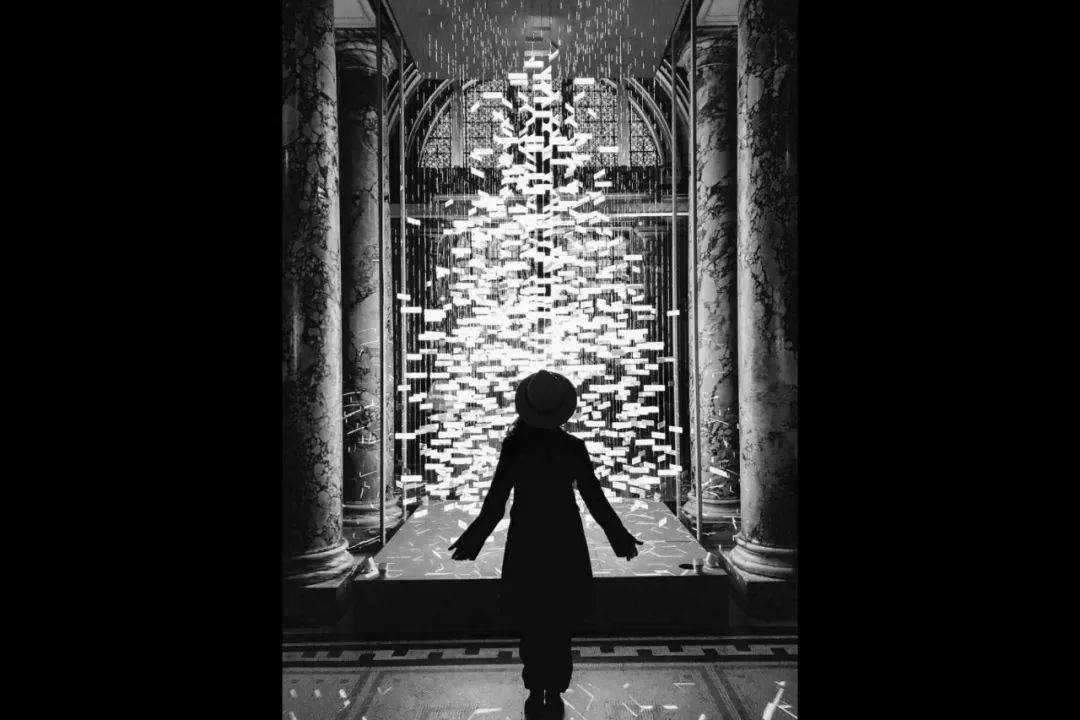 Es Devlin and London's V&A jointly created a collective choral installation "The Singing Tree"
Es Devlin and London's V&A jointly created a collective choral installation "The Singing Tree"
Perhaps due to the limitations of the current perspective, the art that sits deep in the blue ocean of AIGC still has a lot of unknowns that are worth exploring. Today, it seems more difficult for us to distinguish and juxtapose science and art, and the integration of the two is becoming increasingly profound and diverse. When reason, logic, and pragmatism try to provide a precise and grand direction of development, sensibility, personal values, and idealism usually fight back, providing another dimension of thinking and reminding us that we need to always ask about possibilities beyond the "ordinary path." .
Even if one can approach the "sun" without restriction through the "Wings of Icarus", the final destination of art will always be the fertile soil under one's feet. Originating from human nature, relating to human nature, and reflecting human nature can be regarded as the only footnote for the everlasting nature of art.
【references】
[1]Merzmensch. (2020). Pareidolia of AI —— The Beauty of Failing by the Artificial Intelligence. Towards Data Science.
[2]Christies. (2018). Is artificial intelligence set to become art's next medium? Available at: https://www.christies.com/features/A-collaboration-between-two-artists-one-human -one-a-machine-9332-1.aspx
[3]Jizhi Club. (2022). Behind the art of AI: Detailed explanation of text generation image model. Available at: https://swarma.org/?p=37227
[4]Angus Russell. (2023). What you need to know about AI-generated art. Venturebeat. Available at: https://venturebeat.com/ai/what-you-need-to-know-about -ai-generated-art/
[5]AIGC Industry News. (2023). AIGC is quietly changing the definition model of art and creation. Available at: https://www.aigc.cn/4073.html
[6] Laika Think Tank Shiba Inu. (2022). AIGC sets off a wave of contemporary new art. Jiemian News. Available at: https://www.jiemian.com/article/8569125.html
[7]Angus Russell. (2023). What you need to know about AI-generated art. Venturebeat. Available at: https://venturebeat.com/ai/what-you-need-to-know-about -ai-generated-art/
[8]Kayla Yup. (2023). What AI art means for society, according to Yale experts. Yale Daily News. Available at: https://yaledailynews.com/blog/2023/01/23/what- ai-art-means-for-society-according-to-yale-experts/
[9] Liu Qiushan. (2022). A long article of 10,000 words explains the art of AI: origin, meaning and future. Babbitt. Available at: https://www.8btc.com/article/6788196
[10]Joseph Wakelee-Lynch. (2023). AI’s Impact on Artists. LMU Magazine. Available at: https://magazine.lmu.edu/articles/mimic-master/
[11]Wesfan. (2021). Will human and AI collaboration and co-creation become the future of digital art? Available at: https://mirror.xyz/wesfan.eth/tkvqGTP9Mhi7fe6lKCQL-fNpbkW4k2l4jFdp8HA60rw
[12] Wang Jiajian. (2022). From digital twins to digital immortality, the “three-stage theory” of the development of the metaverse丨Explore the metaverse with Chang Chai. Available at: https://www.8btc.com/ article/6732184
[13]Teng Yan. (2023). Botto: The Decentralized AI Artist. Available at: https://members.delphidigital.io/reports/botto-the-decentralized-ai-artist#introduction
[14]Refik Anadol. (nd). Biography. Available at: https://refikanadol.com/information/
[15]Es Devlin. (nd). Information. Available at: https://esdevlin.com/information
[16]Rebecca Fulleylove. (2018). Es Devlin On The Concept Behind 'Please Feed The Lions'. Google Arts & Culture. Available at: https://artsandculture.google.com/story/IQUhsVDB1XB3IA
Pictures come from the Internet
If there are any copyright issues, please contact the editor to delete
Editorial Director | Amber
Editor | ica
Design | Muzi
Coordination | Michelle
The above is the detailed content of AIGCx Art: Blue Ocean or Challenge? See how the art world embraces artificial intelligence?. For more information, please follow other related articles on the PHP Chinese website!
 The difference between git and svn
The difference between git and svn
 How to recover completely deleted files on computer
How to recover completely deleted files on computer
 The difference between Java and Java
The difference between Java and Java
 what is python range
what is python range
 How to run code html in vscode
How to run code html in vscode
 What happens when software crashes?
What happens when software crashes?
 Is Bitcoin trading allowed in China?
Is Bitcoin trading allowed in China?
 Windows cannot find the solution to the certificate
Windows cannot find the solution to the certificate




